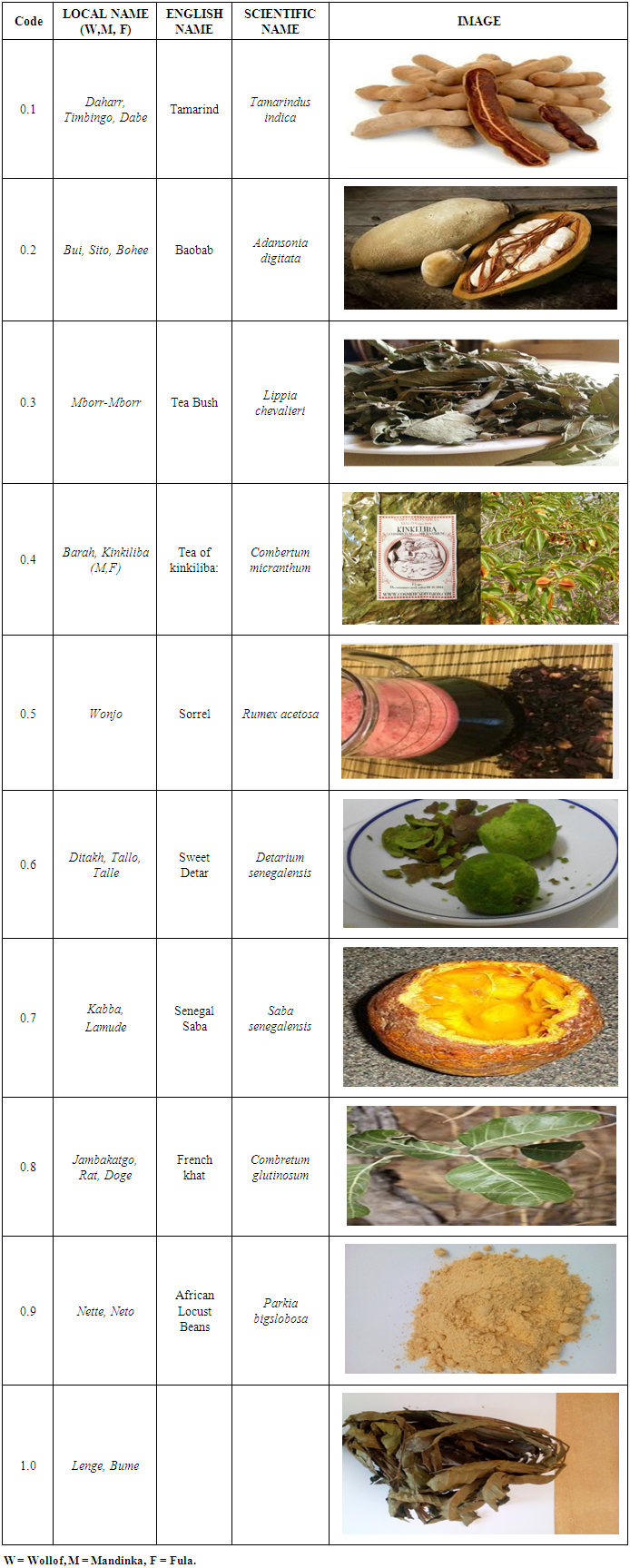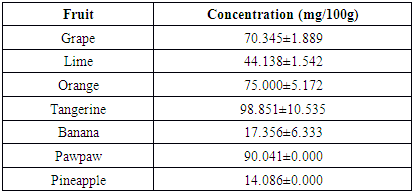-
Paper Information
- Next Paper
- Paper Submission
-
Journal Information
- About This Journal
- Editorial Board
- Current Issue
- Archive
- Author Guidelines
- Contact Us
Food and Public Health
p-ISSN: 2162-9412 e-ISSN: 2162-8440
2020; 10(3): 68-71
doi:10.5923/j.fph.20201003.02
Received: Aug. 18, 2020; Accepted: Sep. 10, 2020; Published: Oct. 26, 2020

Ascorbic Acid Analysis in Selected Indigenous Gambian Foods by Use of Titrimetric Analysis in Aqueous Media
Alieu M. Kandeh1, Matarr Gaye1, Osaro Iyekowa1, 2, Oladele Oyelakin1, Mandalena Mendy1, Chukwudozie Cyril Ntomchukwu1, 3, Adjivon Anthony1
1Chemistry Unit, Division of Physical & Natural Sciences, School of Arts & Sciences, University of The Gambia, The Gambia
2Department of Chemistry, Faculty of Science, University of Benin, Nigeria
3College of Medicine, American International University, West-Africa, The Gambia
Correspondence to: Oladele Oyelakin, Chemistry Unit, Division of Physical & Natural Sciences, School of Arts & Sciences, University of The Gambia, The Gambia.
| Email: |  |
Copyright © 2020 The Author(s). Published by Scientific & Academic Publishing.
This work is licensed under the Creative Commons Attribution International License (CC BY).
http://creativecommons.org/licenses/by/4.0/

Data on Gambian foods is few and far between; this research looks at vitamin C content of selected Gambian foods. Ten different Local Gambian Foods were analysed for their vitamin C content in aqueous solutions using titrimetric method and results obtained suggested that the amount of vitamin C in these samples is sufficient for human daily requirement. Results of the analysis further showed that five of the samples analysed ranged from 27.47 to 60.23mg/100g, while the other five samples ranged from 117.72 to 703.88mg/100g. Detarium senegalenses has the highest amount of vitamin C content.
Keywords: Vitamin C, Ascorbic Acid, Indigenous, Detarium Senegalenses, Gambia, Titrimetric method
Cite this paper: Alieu M. Kandeh, Matarr Gaye, Osaro Iyekowa, Oladele Oyelakin, Mandalena Mendy, Chukwudozie Cyril Ntomchukwu, Adjivon Anthony, Ascorbic Acid Analysis in Selected Indigenous Gambian Foods by Use of Titrimetric Analysis in Aqueous Media, Food and Public Health, Vol. 10 No. 3, 2020, pp. 68-71. doi: 10.5923/j.fph.20201003.02.
Article Outline
1. Introduction
- Ascorbic acid or vitamin C is it is commonly known belongs to a class of water soluble organic compounds that is required by the body for its numerous biological functions. The functions of vitamin C in the body are numerous and invaluable. These relate to its ability to donate an electron as it is well-known for its antioxidant role in aqueous media [1]. In addition to its antioxidant effects, vitamin C is reported to be useful in cancer treatment. Vitamin C also helps in the treatment of cancer and the reduction of developing cervical cancer and prostate cancer in the human body [2]. Vitamin C is almost present in all foods of plant origin. The best sources of vitamin C are fruits and vegetables. Some foods particularly rich in vitamin C includes: tomato, cabbage, garlic, ginger, pepper, cherry, apple, lime etc [3]. In Africa, some foods exist which are rich in vitamin C and are not known to the wider world. This work will make this known, in special relation to The Gambia, a rather small lesser known country in West-Africa. Further to this, the afore-listed fruits and vegetables are usually more costly compared to indigenous ones. Knowledge of less expensive options would make a difference to locals vis-à-vis sources of vitamin C. Analysis of vitamin C is important in determining the best sources of vitamin C. Several methods exist of doing this; examples of the methods include, titrimetric methods, hyphenated technique using instruments consisting of flow injection analysis, sensors and biosensors, high performance liquid chromatography, capillary electrophoresis and so on [4]. Some of these methods require technical know-how and are expensive. Others are time consuming, less sensitive and have low detection limits. This work deals with use of titrimetric method. This method is simple and inexpensive. The simplicity of the chosen method is well-suited to an under-resourced environment. Further to this, this work has as its objective, the determination of ascorbic acid in some indigenous Gambian foods in aqueous solutions. There is little data on indigenous Gambian foods. This study aims to make this data available. This research aims to answer the following research questions: what are the amounts of vitamin C in indigenous Gambian Foods in mg/100g? Are the levels of vitamin C in indigenous Gambian foods sufficient for daily human requirements? This research aims to contribute to scientific knowledge and results obtained will serve as reference for future findings on indigenous Gambian Foods.
2. Materials & Methods
- Chemicals and instrumentationAll chemicals used were purchased from Fisher Chemicals. Starch solution, potassium iodide, potassium iodate, hydrochloric acid and ascorbic acid. Digital Analytical Balance that measures up to 0.001g was used for weighing throughout the study. Procedure reactionThe titrimetric analysis method used in this study to determine ascorbic acid is typically called iodometric titration. Standardization A standard solution of 1.0×10-2 M KIO3 was prepared by dissolving 2.140g of KIO3 in 1000mL of distilled water. 0.260g of ascorbic acid in 100mL was used to confirm the concentration of the standardized KIO3. A 5% standard solution of starch was prepared by dissolving 0.500g of starch powder in 100mL distilled water. Standardization was repeated for each sample being analyzed. Samples and Sample SelectionDifferent samples of indigenous Gambian foods were purchased from Brikama and Serrekunda Markets; some were collected from the Brikama Forest. A total of ten different samples were analysed using titrimetric method. For each sample, different parts of the plant was used. The used parts were, (according to the listed code in table 1): 0.1 fruit; 0.2 fruit (white part in photo); 0.3 leaves; 0.4 leaves; 0.5 leaves; 0.6 fruit; 0.7 fruit; 0.8 leaves, 0.9 fruit; 1.0 leaves.
|
3. Results and Discussion
- The table below shows the average titre values for each sample and the amount of vitamin C in mg/100g for each sample.
|
|
4. Conclusions
- The US recommended dietary allowance for ascorbic acid is from 100 - 120 mg/per day for adults [6]. Results obtained from the food samples analyzed suggest that a good number of Gambian Local Foods meet this requirement. Considering the fact that these foods are often consumed in their natural state, it is logical to conclude that using them to replace imported foods will largely ameliorate vitamin C requirement in The Gambia. After critically looking at available literature and the results obtained from the food samples analyzed, the following recommendations are provided for consideration:1. Consumption of these local Gambian Foods for their vitamin C content should be encouraged.2. It is recommended that these foods be processed and preserved so as to make them available all year round.
5. Implications for Chemical Education
- This study has dealt with indigenous African food. With special reference to chemical education, the following are noteworthy: 1. In teaching about food and nutrition, examples of locally grown plants should be used in schools; the use of examples that relate to foods grown in Europe and America should be minimized or discourage altogether. 2. All locally grown African foods and which are not known to the wider world should be analysed for their nutritional value.
ACKNOWLEDGEMENTS
- Appreciation goes to National Agricultural Research Institute, Brikama, The Gambia for provision of glassware and distilled water.
 Abstract
Abstract Reference
Reference Full-Text PDF
Full-Text PDF Full-text HTML
Full-text HTML

